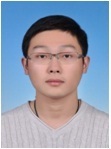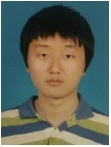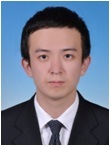Yulin Shi(史玉琳),Postdoc | ||
 | Yulin Shi, obtained his BS and MS degrees in chemical technology at XinJang University. In April 2012, he received his Ph.D in fine chemicals at Dalian University of Technology. From April 2012 to August 2013, he worked for CNOOC Tianjin Chemical Research & Design Institute as a chemical engineer. He entered into School of Chemical Engineering, ShiHeZi University as a research staff in September 2013. Up to now, he has published 4 papers in material chemical engineering related journals, such as Carbohydrate Polymers and so on. His research area contains: (1) Stimuli-reponsive polymers: synthesis, properties and applications; (2) Preparation of Ni/Zn/Si composite material and its application in synthetic polymers hydro-upgrading catalyst. |
| Xiaogang Gu(顾小刚),Postdoc | ||
 | GuXiaogang, postdoctor, Ph.D. in environmental science and engineering, graduated from East China University of Science and Technology in June 2014. I am focusing on the remediation of organic contaminants in groundwater by means of advanced oxidation processes (AOPs), and my interests include development of novel activation technologies of common oxidants, investigation of redox processes during oxidants activation, and the interaction between AOPs and chemical constituents in subsurface environment. |
| WeihuaWang(王伟华),Ph. D. Candidate | ||
 | Wang Weihua, Ph. D student, graduated from Qingdao University of Science and Technology in June 2009 and the second year of doctor degree in East China University of Science and Technology now. My main subject is synthesis of multi-functional spherical polyelectrolyte brushes(SPBs) and characterization by small angle x-ray scattering(SAXS). SPBs consist of polystyrene(PS) cores onto which polyacrylic acid(PAA) are densely grafted which can be used as nanoreactors of synthesis of nano-mental particles, magnetic particles and adsorption of proteins. SAXS can be applied to characterize (1)particle size, shape and distribution; (2)particle dispersion; (3)particle volume fraction and specific surface area; (4)interfacestructure and the degree of phase separation between the particles and medium; (5) the interaction between particles. SAXS is proved to be a result-statistical, test-rapid, sample-nondestructive and preparation-simple method compared with other nano-scaled analysis methods, such as SEM, TEM, AFM. |
| Jing Huang(黄婧),Ph. D. Candidate | ||
|
| Huangjing, Ph.D. candidate with major in chemical technology, acquired bachelor degree in East China University Of Since And Technology in 2009. My subject is about the adjustment and improvement of the rheology of complex fluid, including crude oil and coal water slurry (CWS), through amphiphilic comb-like copolymer. Some of the major problems in oil processing, transformation and storage are wax deposition on oil pipe walls and the high viscosity, which causes flow problems and costs plenty of energy. The synthesized oil-soluble comb-like copolymer would interact with the asphaltene and wax in crude oil, resulting a reduction in wax precipitation and enhanced flowability of oil. Meanwhile, a series of synthesized water-soluble copolymers are applied in CWS as well. As fuel of oil alternatives, CWS is required to have a solid content as high as posible and a good flowability. Thus the settling and high viscosity of the dispersion are big challenges. The copolymer dispersants can adsorb on the surface of coal particles, which provides electrostatiic repulsion and steric hindrance among coal particles, improve the rheology and stability the suspension, and enable a more concentrated CWS. |
| Mingwei Wang(王铭纬),Ph. D. Candidate | ||
 | Wang Mingwei, Chemical Technology, Doctor Candidate. I graduated from Henan University in 2010 and now study in East China University of Science and Technology. My research subject is Novel Nanoparticle based on Cyclodextrin by Flash Nanoprecipitation in Multi-inlet Vortex Mixer. Due to its ultra-small size, nanoparticle can pass through the organization clearance and be absorbed by the cells as a drug carrier, which shows great potential and is widely researched. The size of nanoparticles should be larger than 70 nm to prevent their rapid clearance because of renal filtration, but smaller than 300 nm to escape capture by phagocytic cells located in reticuloendothelial system. However, all of the traditional methods have some problems in size distribution. A novel approach to generate nanoparticles is Flash NanoPrecipitation (FNP), a scalable process with controlled size distribution and a high drug-loading rate (DLR), in which nanoparticles are precipitated from polymer chains in solution as a result of displacing a solvent with a non-solvent. |
| Yu Cang(仓钰),Ph. D. Candidate | ||
 | Cang Yu, Ph. D student, graduated from East China University of Science and Technology in July 2010 and is having further study for a doctor’s degree. My research is aimed at preparation of multiresponse spherical polyelectrolyte brushes and hydrogel which was linked by nanoparticals. Hydrogels are three—dimensional hydrophilic polymer networks used in many areas,such as soil amelioration, medicine, hygiene, biomedical applications and so on.For practical utilities, most hydrogels must be able to operate against an external load, and thus hydrogels with high mechanical strength are required.However, the industrial and biomedical applications of ordinary hydrogels made from synthetic sources are strongly limited by their poor mechanical properties. My research is aimed at systhetizedhydrogels that were crosslinked by nanoparticals and thermosensitive polymers were initiated by photo and heat. The characteristics of transparency, swelling, rheological properties and elongation were improved. We also use domestic JKR intelligent instrument which was set up by our group to research the structure and energy of hydrogels. |
| Xiaochi Liu(刘小驰),Ph. D. Candidate | ||
 | Xiaochi Liu, the major of material chemical engineering, M-D postgraduate, graduated from the major of the chemical engineering and technology in East China University of Science and Technology, is studying in the chemical engineering Institute of East China University of Science and Technology. My research’s aimed at preparation and application of inorganic-organic hybrid polymer materials and my topic is the synthesis of Fluorescent spherical polyelectrolyte brush (SPB) and PVK-PAA brushes with optical activity. Quantum dots, which is an organic material that fluoresce under UV irradiation, can be inserted into polystyrene core to make SPB labeled. This kind of carrier is available for protein encoding procedure and medical identification. Poly(N-vinylcarbazole) (PVK) has optical activity and it’s usually used as LCD material. PVK-PAA brush, which consists of a PVK core and a shell of PAA chains, has potential applications in new type of optical nanodevices. |
| Weina Wang(王维娜),Ph. D. Candidate | ||
 | Wang Weina,My thesis was “The study of rheology and adhesive mechanism on hydrogels and the applications in biochemistry”. Hydrogels are hydrophilic polymers that are crosslinked to form insoluble, but water-swellable networks. They are with high water content, flexibility in tailor-made physiochemical properties, and closely resemblance to human tissue. Mussel adhesive proteins are the natural products from marine organisms. They are friendly to the environment and have the advantages of wide application、high curing rate,corrosion resisting ability、high strength,good biocompatibility, thus this neotype bio-adhesives has great value in biomedical aspects. However, only 1g mucous with super strength can be extracted from 10000 mussels. This process is really complicated and costly and can’t meet the demand in reality, therefore the bionic polymer of mussel emerge as the times require. In this paper, we will base on the different cross-linking mechanisms to explore the adhesive DOPA material and compare the differences between its derivants, control the flowing and adhesive property to study the inner adhesive mechanism. |

























